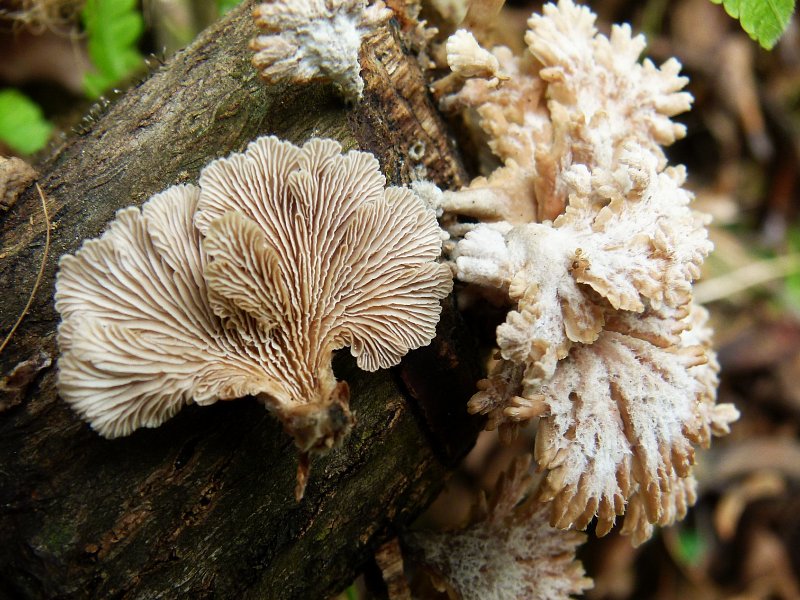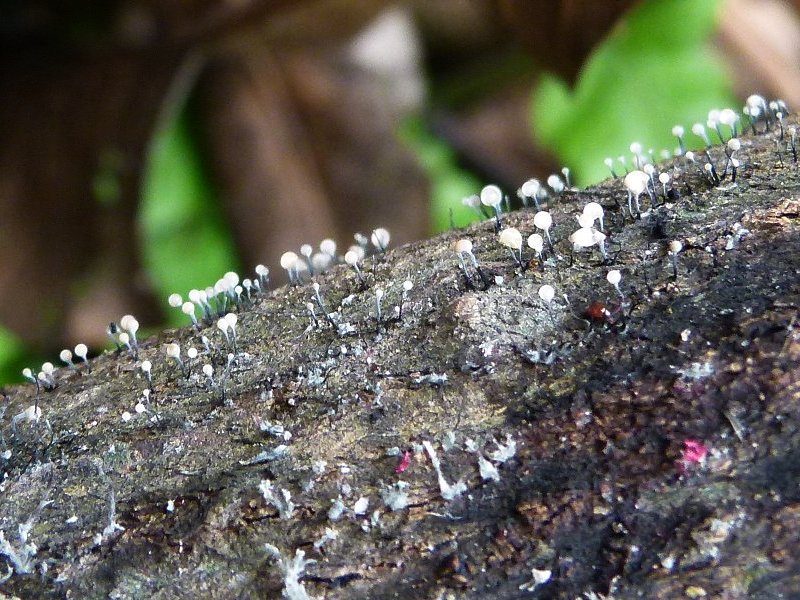Schizophyllum commune Fries (Syn: Agaricus alneus L., (1755); Agaricus alneus Reichard, (1780); Agaricus multifidus Batsch, (1786); Apus alneus (L.) Gray, (1821); Merulius alneus (L.) J.F. Gmel., (1792); Merulius alneus (Reichard) Schumach., (1803); Merulius communis (Fr.) Spirin & Zmitr., (2004); Schizophyllum alneum J. Schröt., (1889); Schizophyllum alneum (Reichard) Kuntze, (1898); Schizophyllum commune var. multifidum (Batsch) Cooke, (1892); Schizophyllum multifidum (Batsch) Fr., (1875)); Schizophyllum commune is a very common species of mushroom in the genus Schizophyllum. It is the world’s most widely distributed mushroom, occurring on every continent except Antarctica.[1] Although European and US guidebooks list it as inedible, this is apparently due to differing standards of taste rather than known toxicity, being regarded with little culinary interest due to its tough texture. S. commune is, in fact, edible and widely consumed in Mexico and elsewhere in the tropics.[2] The authors explain the preference for tough, rubbery mushrooms in the tropics as a consequence of the fact that tender, fleshy mushrooms quickly rot in the hot humid conditions there, making their marketing problematic. The gills, which produce basidiospores on their surface split when the mushroom dries out, earning this mushroom the common name Split Gill. It has more than 28,000 sexes.[1] It is common in rotting wood, but can also cause disease in humans.[3]Hydrophobin was first isolated from Schizophyllum commune. The cap is shell-shaped, with the tissue concentrated at the point of attachment, resembling a stem. It is often wavy and lobed, with a rigid margin when old. It is tough, felty and hairy, and slippery when moist. It is greyish white and up to 4 cm in diameter. The gills are pale reddish or grey, very narrow with a longitudinal split edge which becomes inrolled when wet; the only knows fungus with spit gills that are capable of retracting by movement. It is found predominantly from autumn to spring on dead wood, in coniferous and deciduous forest. (From Wikipedia on 12.8.13) Hooghly – maybe Schizophyllum commune Fries: Attachments (8). 11 posts by 4 authors. Found today (6.8.13) on dead mango branches, to be used as fuel wood later. Can’t confirm the ID as I don’t know this fungi This is indeed Schizophyllum commune. I highly appreciate your series of accurate photography of the basidiocarp. Yes, that is Schizophyllum Thank you …, I also have a third confirmation mail (not forwarded to group). S. commune is very broadly distributed and certainly there are lots of different forms for this species: the finger-like projects on yours are striking. But the split gills, that fork just before reaching the cap edge, help to confirm this ID. Some folks in the tropics actually gather and eat this as an edible species. It is also cultivated for food. Go figure. The field guide i have also informs that some community eat this mushroom, have some medicinal property, Many many thanks to … Location: Chautara,, Nepal Altitude: 4700 ft. Date: 19 January 2014 Nepali Names : मिजु च्याउ Mizu Chyaau / काठे बगाले च्याउ Kaathe Bagaale Chyaau
Kathmandu, Nepal 4400ft. 5 December 2015
SK1779 08 Feb 2019 – Mycophyta : 5 posts by 4 authors. Attachments (1) Location : Chautara, Sindhupalchok, Nepal Date : 24 January 2014 Elevation : 1300 m. Habit : Wild Schizophyllum commune for sure…. cannot miss the characteristic ‘split gills’….
SK1884 03 May 2019 – Mycophyta : 3 posts by 2 authors. Attachments (2)- around 900 kb each. Location : Gyaneswor, katghmandu Date : 2 May 2019 Elevation : 1300 m. Habit : Wild Schizophyllum commune Fr.:Fr. ?? May be as per Yes …! Mycophyta – presenting for ID Location : Chennai outskirts Date :13.09.2019 Elevation : 23 mts. Habitat :Urban garden Habit : Backyards after rain Schizophyllum commune Fr.:Fr.
SK 2548 18 March 2020 – Mycophyta : 8 posts by 3 authors. Attachments (1)- 814 kb. Location: Pharping Date: 05 July 2014 Elevation: 1500 m. Habit : Wild Pl. check comparative images at Order Agaricales Yes Schizophyllum commune Thank you … Could not guess because of big mass! Schizophyllum commune References: |
Schizophyllum commune
Updated on December 24, 2024








